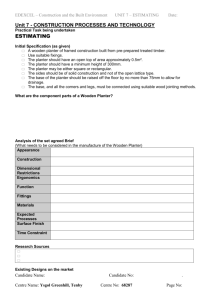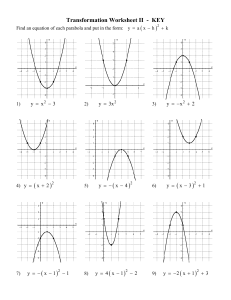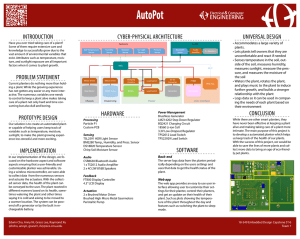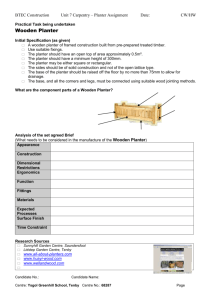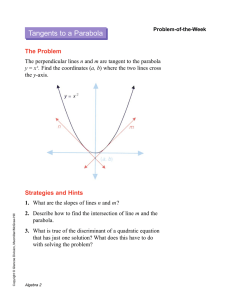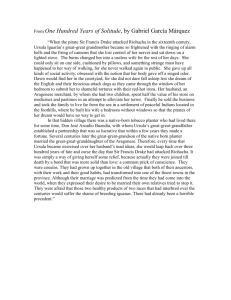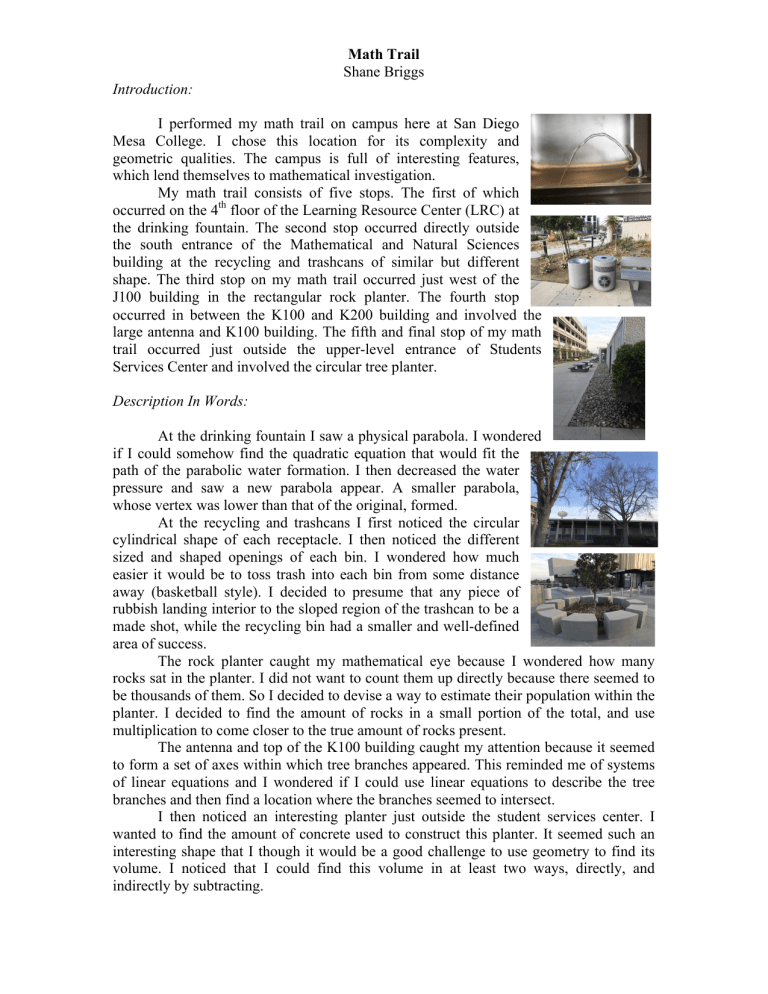
Math Trail Shane Briggs Introduction: I performed my math trail on campus here at San Diego Mesa College. I chose this location for its complexity and geometric qualities. The campus is full of interesting features, which lend themselves to mathematical investigation. My math trail consists of five stops. The first of which occurred on the 4th floor of the Learning Resource Center (LRC) at the drinking fountain. The second stop occurred directly outside the south entrance of the Mathematical and Natural Sciences building at the recycling and trashcans of similar but different shape. The third stop on my math trail occurred just west of the J100 building in the rectangular rock planter. The fourth stop occurred in between the K100 and K200 building and involved the large antenna and K100 building. The fifth and final stop of my math trail occurred just outside the upper-level entrance of Students Services Center and involved the circular tree planter. Description In Words: At the drinking fountain I saw a physical parabola. I wondered if I could somehow find the quadratic equation that would fit the path of the parabolic water formation. I then decreased the water pressure and saw a new parabola appear. A smaller parabola, whose vertex was lower than that of the original, formed. At the recycling and trashcans I first noticed the circular cylindrical shape of each receptacle. I then noticed the different sized and shaped openings of each bin. I wondered how much easier it would be to toss trash into each bin from some distance away (basketball style). I decided to presume that any piece of rubbish landing interior to the sloped region of the trashcan to be a made shot, while the recycling bin had a smaller and well-defined area of success. The rock planter caught my mathematical eye because I wondered how many rocks sat in the planter. I did not want to count them up directly because there seemed to be thousands of them. So I decided to devise a way to estimate their population within the planter. I decided to find the amount of rocks in a small portion of the total, and use multiplication to come closer to the true amount of rocks present. The antenna and top of the K100 building caught my attention because it seemed to form a set of axes within which tree branches appeared. This reminded me of systems of linear equations and I wondered if I could use linear equations to describe the tree branches and then find a location where the branches seemed to intersect. I then noticed an interesting planter just outside the student services center. I wanted to find the amount of concrete used to construct this planter. It seemed such an interesting shape that I though it would be a good challenge to use geometry to find its volume. I noticed that I could find this volume in at least two ways, directly, and indirectly by subtracting. Calculations: Stop #1 (Drinking Fountain): For the larger parabola I used the point 0, 2.55 , −3.25, 6.92 , (−9.56, 3.88). For the smaller parabola I used the points 0, 2.55 , −1.50, 4.37 , (−4.80, 2.38). In order to find particular functions in the form 𝑓 𝑥 = 𝑎𝑥 ! + 𝑏𝑥 + 𝑐, I solved the following systems of linear equations that describe each parabola. Larger Parabola: 𝑎 0 𝑎 −3.25 𝑎 −9.56 ! + 𝑏 0 + 𝑐 = 2.55 + 𝑏 −3.25 + 𝑐 = 6.92 ! + 𝑏 −9.56 + 𝑐 = 3.88 ! Solving resulted in: 𝑓! 𝑥 = −0.19𝑥 ! − 1.97𝑥 + 2.55 Smaller Parabola: 𝑎 0 𝑎 −1.50 𝑎 −4.80 ! + 𝑏 0 + 𝑐 = 2.55 + 𝑏 −1.50 + 𝑐 = 4.37 ! + 𝑏 −4.80 + 𝑐 = 2.38 ! Solving resulted in: 𝑓! 𝑥 = −0.38𝑥 ! − 1.78𝑥 + 2.55 Graph in Desmos: Stop #2 (Recycling and Trashcan): I calculated the area of each circle. The diameter for these is indicated above. That is, the arrows above are defining each circle diameter. To how much more likely one is to make a shot from some distance from the bins, I calculated the area of these circles. Recycling: 𝐴𝑟𝑒𝑎 = 𝜋 15 𝑐𝑚 2 𝐴𝑟𝑒𝑎 = 𝜋 39 𝑐𝑚 2 Trashcan: !!"#.! !!! ! ≈ 176.7 𝑐𝑚! ! ≈ 1194.6 𝑐𝑚! So a person would be about !"#.! !!! ≈ 6.8 times more likely of making the shot into the trashcan as compared to the recycling bin. Stop #3 (Rectangular Rock Planter): I did not want to use my measuring tape to measure the very long planter. So I decided to use my steps (shoes). As shown in the above-left photo, the rectangular planter was 52 shoes long by 4.5 shoes wide. With the conversion factor of 1 𝑠ℎ𝑜𝑒 = 12.5 𝑖𝑛 I was able to find the area of the planter in the units of square feet. 52 𝑠ℎ𝑜𝑒𝑠 ⋅ !".! !" ! !!!" = 650 𝑖𝑛 and 4.5 𝑠ℎ𝑜𝑒𝑠 ⋅ !".! !" ! !!!" = 56.25 𝑖𝑛 So the area of the planter is… 650 𝑖𝑛 ⋅ 56.25 𝑖𝑛 = 36,562.50 𝑖𝑛! Converting this to square feet we have… 1 𝑓𝑡 36,562.50 𝑖𝑛 ⋅ 12 𝑖𝑛 ! ! = 253.91 𝑓𝑡 ! I counted about 40 rocks in two different same square feet of rocks. I therefore have the relationship 1 𝑓𝑡 ! ≈ 40 𝑟𝑜𝑐𝑘𝑠. I can now use multiplication to find an estimate for the total number of rocks in the planter. Therefore, there are about 40 !"#$% !! ! ⋅ 253.91 𝑓𝑡 ! = 10,156 𝑟𝑜𝑐𝑘𝑠 in the planter. Stop #4 (Large Antenna & K100): For the pink line above I used the points highlighted above. Using the antenna and building markings as my scale I was able to identify linear equations that describe a pair of branches in the tree. Pink Line Points: 0, 3 , (0.8, 2.5) !.!!! ! Slope: 𝑚 = !.!!! = − ! ! Equation: 𝑦 − 3 = − ! 𝑥 − 0 ! → 𝑦 = −!𝑥 + 3 Green Line Points: 1, 3 , (2.5, 1) !!! ! Slope: 𝑚 = !.!!! = − ! ! Equation: 𝑦 − 3 = − ! 𝑥 − 1 → ! 𝑦 = −!𝑥 + !" Setting these two equations equal we get… ! ! −!𝑥 + 3 = −!𝑥 + !" ! → !" ! 𝑥=! → 𝑥= !" 𝑦=− ! ! !" !" !" = !" ≈ 1.9 4 32 13 31 + = ≈ 1.8 3 17 3 17 So we get the intersection point 1.9, 1.8 ! Stop #5 (Student Services Planter): I will now calculate the volume of concrete used to form the planter. If the planter were not segmented and were simply a complete circular cylinder, then we would have its volume as… 𝑉𝑜𝑙𝑢𝑚𝑒 = 𝜋 84 𝑖𝑛 ! ⋅ 18.5 𝑖𝑛 ≈ 410,090.94 𝑖𝑛! We now need to subtract away the inner circular cylinder… 𝑉𝑜𝑙𝑢𝑚𝑒 = 𝜋 60 𝑖𝑛 ! ⋅ 18.5 𝑖𝑛 ≈ 209,230.07 𝑖𝑛! So we now have… 410,090.94 𝑖𝑛! − 209,230.07 𝑖𝑛! = 200,860.87 𝑖𝑛! Now we need to subtract away the 11 rectangular prisms. So we have the volume of concrete used to form the planter as roughly… 200,860.87 𝑖𝑛! − 11 ⋅ 12 𝑖𝑛 ⋅ 24 𝑖𝑛 ⋅ 18.5 𝑖𝑛 = 142,252.87 𝑖𝑛! In cubic feet we have… 142,252.87 𝑖𝑛 ! 1 𝑓𝑡 12 𝑖𝑛 ! = 82.32 𝑓𝑡 ! Summary: I developed this project because I wanted my students to realize that mathematics is not simply a subject confined to classrooms and textbooks. I want my students to interact with their everyday surroundings in a mathematical way and take the mathematics out of the classroom. I want my students to creatively apply mathematical topics in the course to places familiar to them. My hope is that my students are inspired and empowered to work with the subject in a way more similar to how mathematicians interact with the subject. I want my students to build a personal relationship to the subject through this project. My goal is to encourage students to view their world through a mathematical lens. And finally, I want to show my students there are many different ways to connect to our world. Slowing down to smell the roses is wonderful, but slowing down to measure the roses is just as sweet. Have fun!

